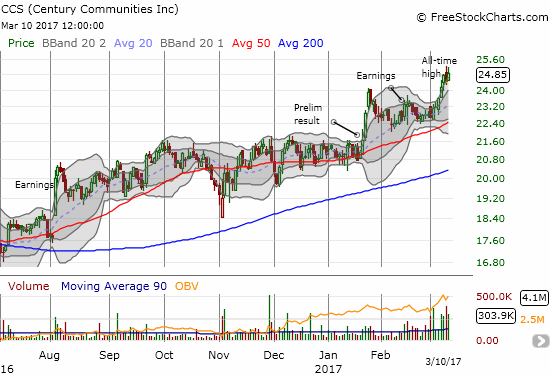Century Communities (CCS) just made a new all-time high and yet it is still a cheap stock. CCS sits at a 0.5 price/sales ratio, 1.1 price/book ratio, 10.7 trailing P/E, and 7.6 forward P/E. Home builders typically hit 1.0 price/book ratios at the BOTTOM of a recessionary cycle. The response to CCS’s latest earnings report was a great example of the market’s reluctance to buy into the company’s story. The stock traded up 3.3% in response to earnings and then promptly lost those gains in a week’s time.

Century Communities broke out to new all-time highs a full three weeks after posting earnings. Another scramble to catch up is underway…
As I stated in my last Housing Market Review, I put CCS back on my buy list pending the results of this earnings report. I took the market’s reluctance as a buying opportunity, but I failed to get back in until CCS powered its way toward a new all-time high.
Back in $CCS at $24 today. Background here: https://t.co/IGHpBoEuI2 Earnings analysis coming… #122trade
— Dr. Duru (@DrDuru) March 8, 2017
The headline results from the Q4 earnings report for CCS on February 14, 2016 were strong.
For 2016, CCS earned a record $2.33/share which represented a 23.9% increase over 2015. These results marked an incredible 14-year run of positive annual results. Management provided guidance on 2017 earnings in the conference call (from the Seeking Alpha transcript):
“…we expect net income trends to be seasonally similar to 2016. Our first quarter will experience our lowest closing and net income. After the first quarter we expect earnings to grow as the year progresses.”
Revenue grew 38.9% year-over-year to reach almost a billion dollars. The company expects to grow revenue to $1.0-$1.2B in 2017. Adjusted homebuilding gross margin percentage stayed roughly flat going from 21.9% in 2015 to 21.7% in 2016. CCS ended the year with one more open community from 2015’s 88 open communities. The company expects to grow this aggressively in 2017 to 90 to 100 open communities at the end of 2017. These communities will grow home deliveries from 2016’s 2,825 to 3,000 to 3,300. Growth in contracts and backlog came almost entirely from organic growth led by Nevada, Central Texas and Colorado.











Leave A Comment